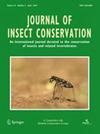原生森林边缘增加了草原蝴蝶栖息地的复杂性和避难机会
IF 1.9
3区 农林科学
Q2 ENTOMOLOGY
引用次数: 0
摘要
局部和景观尺度上的异质性可以促进昆虫多样性,缓解全球变化导致的昆虫数量减少。确定物种如何对不同的景观成分做出反应,有助于深入了解异质性在景观变化中的作用。我们研究了蝴蝶是如何利用原生森林-草地边缘的。我们评估了森林边缘和毗邻草原的蝴蝶多样性和行为,并测试了这些模式是否受到季节之间不同天气条件的影响。森林边缘支持种类丰富的蝴蝶群落。森林专家在森林边缘的多样性高于草地,而草地专家和生境通才在森林边缘的多样性与草地相同。所有蝴蝶类群表现出更多的种间和种内相互作用,在森林边缘表现出更多的巡逻行为,而在草地表现出更多的摄食和短暂行为。发生和行为模式不受季节的影响,这表明森林的影响不会随着环境条件的变化而改变。然而,某些物种在炎热多风的季节更倾向于利用森林边缘,这表明森林边缘提供的庇护影响了蝴蝶对栖息地的利用。我们没有发现互补花蜜来源影响蝴蝶分布模式的证据。对昆虫保护的启示:原生森林边缘支持的蝴蝶的多样性组合和行为范围表明,森林斑块是蝴蝶栖息地的重要组成部分。保护这些沿海草原的森林斑块可能有助于缓冲蝴蝶种群对全球变化的影响。本文章由计算机程序翻译,如有差异,请以英文原文为准。
Indigenous forest edges increase habitat complexity and refuge opportunities for grassland butterflies
Abstract Heterogeneity at local and landscape scales can promote insect diversity and moderate insect declines that stem from global change. Determining how species respond to different landscape components provides insight into the role of heterogeneity in landscapes undergoing change. We examine how indigenous forest-grassland edges are used by butterflies. We assessed butterfly diversity and behaviour at forest edges and adjoining grassland, and tested whether these patterns are influenced by differing weather conditions between seasons. Forest edges supported a species rich butterfly assemblage. Forest specialists were more diverse at forest edges than in grassland, whereas grassland specialists and habitat generalists were as diverse at forest edges as in grassland. All butterfly groups showed more inter- and intra-specific interactions and more patrolling behaviour at forest edges, but more feeding and transient behaviour in grassland. Occurrence and behavioural patterns were not mediated by season, suggesting that the influence of forests does not change with varying environmental conditions. Nonetheless, certain species preferentially utilized forest edges in the hot and windy season, indicating that shelter provided by forest edges influences butterfly habitat use. We found no evidence that complementary nectar sources influence butterfly distribution patterns. Implications for insect conservation : The diverse butterfly assemblages and range of behaviours supported by indigenous forest edges indicate that forest patches are an important habitat component for butterflies. Conserving forest patches in these coastal grasslands may help buffer butterfly populations against global change.
求助全文
通过发布文献求助,成功后即可免费获取论文全文。
去求助
来源期刊
CiteScore
3.60
自引率
10.50%
发文量
76
审稿时长
6 months
期刊介绍:
The Journal of Insect Conservation is an international journal devoted to the publication of articles concerned with the conservation of insects and related invertebrates. The Journal of Insect Conservation publishes papers on all aspects of conservation and biodiversity related to the insects and closely related groups such as Arachnids and Myriapods, including ecological work which has conservation implications. Research papers may address the subject at the community, population or species level, may cover aspects of behaviour, taxonomy or genetics, be theoretical or practical, and be local or global in nature. Review articles are welcome as well as points of view which are likely to stimulate debate. From time to time the journal will publish Special Issues on specific subject areas which are the focus of current research. Proposals for such issues are welcome.

 求助内容:
求助内容: 应助结果提醒方式:
应助结果提醒方式:


